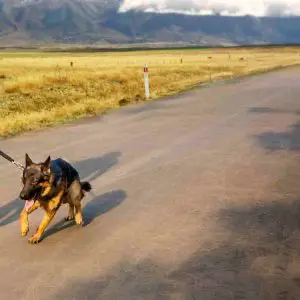
Are German Shepherds Aggressive? It’s shocking to see the amount of untrue accusations on the internet answering this question. A lot of websites deem the German Shepherd dog to be a truly aggressive breed and this simply isn’t true.
True aggression in German Shepherds is very rare. All dogs are capable of displaying aggressive behaviors, but there will usually be a trigger such as perceived danger or fear.
German Shepperd’s are an intelligent loyal breed so if you want to train and nurture them to be aggressive this can be successfully done, which is why they make great guard, security and police dog however just as easily if you want them to be a friendly loyal companion this is also easy to train and nurture.
Table of Contents
Signs Of Aggression:
Some normal dog socialization can look aggressive including barking, lunging, biting, and some growling. It is important to recognize true signs of aggression.
There are several different types of dog aggression. Here are a few of the most common types of aggression and warning signs to help you recognize when to seek professional help:
Territorial: When the mail person turns up, dog barks. When there’s a squirrel in your yard, dog barks, someone walking past the house on the sidewalk? Dog barks. These are signs of territorial behavior. Many different breeds will show this behavior as it is their natural instinct to protect their home although some territorial behaviors are beneficial, like alerting you to potential threats such as strangers others are not so helpful. Later on, in this article, we shall give you some tips on ways to adjust some territorial behaviors in your German Shepherd. Signs of territorial behavior can also include lunging, snapping, biting, aggressive barking, freezing in place and growling.
Fear: Fearful-aggressive dogs are filled with mixed emotions and are difficult to predict. A fearful dog should not be touched as they can bite out of fear. Fearful-aggressive dogs will often display submissive body language, this can include ears being pinned back, lowered head and body, avoidance of eye contact, tail tucked between their legs and submissive urinating.
Dog on dog: Some dogs are fine with humans however if they come across another dog, they may become aggressive. Signs of dog on dog aggression can include raised hackles, teeth exposure towards the other dog, lunging, direct eye contact, and posturing. Growling, barking, and play bows are all fine if your German Shepherds body language is still relaxed. Do not test this behavior out at a dog park. If your dog shows any signs of dog on dog aggression speak to your trainer.
Food and possession: Guarding food and possessions from humans or other animals is a natural normal behavior for dogs. However, this behavior is undesirable, and most people will want to take reasonable precautions. This is especially important if you live with children who are less likely to recognize the warning signs before being bitten. Signs of food and possession aggression can include standing stiffly over the bowl or object, gulping the food quickly, being tense or freezing, snapping, snarling, growling, biting, or chasing people away. For ways to help combat this behavior please see this article here.
Dominate: Dominant-aggressive dogs are dangerous. Often a dominant-aggressive dog will show no warning signs before biting, however, signs can include snarling, growling and snapping, excessive low-range barking, carrying tail high, and moving it swiftly from side to side.
Predatory: Predatory aggression is the sudden, impulsive action of a dog which can result in a grab bite to the abdomen or the jugular. Signs will include your dog stalking their prey. This is where a dog will clock is target and will move silently and quickly towards the target. This may be the only type of aggression your dog may show. Again, this is a natural behavior for a dog as their ancestors would have needed to hunt down their prey. However, this is defiantly a behavior that needs to be nurtured and trained. If your German Shepherd shows any signs of predatory behavior, even if your uncertain it is best to seek professional advice.
Biting if not the only form of aggression. There are many warning signs your pooch will often display before biting.
It is important for anyone who is in contact with any dog to know and look out for the early warning signs before the bite.
Humping is a sign of dominance; this is okay when dogs are working on their social ladder however make sure you monitor this behavior to ensure it doesn’t become too excessive.
If you are not breeding your German Shepherd dog it is highly recommended that you get them neutered. This will often help to reduce aggressive behaviors.
Why Does My German Shepherd Act Aggressively?
There may be times when your German Shepherd feels fearful or sees danger in something which we would not consider to be a threat, if this is the case, they may display certain behaviors that could be perceived as aggressive. A couple of scenarios include:
Your German Shepherd may be the friendliest pooch at the park when he has freedom but becomes a lunging bark machine as soon as leash comes out.
The same may also be true at home. A neighbor walks passed the house- barking. A noise from the street – growling.
A lot of these behaviors are common for many different breeds not just German Shepherds and will require time, training and nurturing to teach your German Shepherd better ways to communicate and to reassure them that these triggers are not a threat.
German Shepherds are bred to be loyal and protective. It is down to us to show them when this behavior is required and when they can come off duty and chill out.
Correcting these aggressive behaviors will not stop it happening in the future to do this you will need to find the trigger.
At one time, German Shepherds had a bad reputation for being dangerous, aggressive dogs. Then it was the turn of the Doberman and now the Staffordshire Bull Terrier. Breed does not necessarily mean aggression.
Let’s take a closer look at what may be triggering your German Shepherd to display these common aggressive behaviors and ways to help prevent it.


Perceived Dangers At Home:
German Shepherds are a strong and confident dog. They have a naturally protective nature and breeders have focused on that through the decades. It is what makes them such good police dogs.
Your German Shepherd can show behavior which may be considered as aggression in many scenarios in the home. The most common behavior is barking at the front door or window when the doorbell rings or somebody walks passed on the street. This barking has two functions; firstly, it is an alert to you that there may be danger and secondly, it is a warning to the perceived threat.
This situation is triggered if your dog feels it is his responsibility to protect the home. he will relentlessly bark and growl until he is confident that the danger has passed. You may notice that he is agitated for a while after this.
So how do you fix it? You need to communicate to your dog that it is your job to protect the home, not his.
- When he barks say “thank you” or “good job” in a calm voice.
- If he continues to bark, go and see what he is barking at. Your presence may calm him into thinking everything is ok.
- If this does not stop his reaction, lead him away and isolate him in another room for a few minutes. Do not talk to him or verbally correct him.
- This period of isolation gives him a chance to calm down and reflect on what just happened.
- You will need to be consistent and repeat this step for step each time he barks at something. Eventually, you should get to a point where your dog barks, you say “thank you” and he immediately stops barking at looks at you.
This look means he is checking with you to see if there is a danger. Calmly tell him it is ok and give him a gently pat.
Perceived Threats In The Garden:
This same teaching method works for perceived aggressive behaviors displayed in the garden. Your dog is barking because he has seen or heard something that he thinks is a threat. In his mind, he is doing his duty by loudly warning you. To correct this, you need to change the routine of going outside.
- When your dog indicates that he wants to go out, make him wait. Let him see you going outside and walking around the garden. Be sure to spend a little time in the areas that most commonly trigger his barking.
- Return to the door and allow him out. If he barks, give your “thank you” and wait for his response.
- If he looks at you, praise him and initiate a short play session. This will reinforce that there is no danger and you are in control of the situation.
- If he continues barking, take him back inside and give him a few minutes to calm down.
- Keep repeating these steps to reinforce the desired behavior.


Perceived Threats On A Walk:
Ok, so you have cracked the situation at home. Your German Shepherd is relaxed and calm. Now the issue is going for a walk. Lunging on the leash and barking are the most common problems German Shepherd owners can experience.
Your dog may display perceived aggression because of several different reasons including:
- Other dogs
- Strangers
- Loud noises
- Unfamiliar smells
Firstly, let’s look at what type of leash and collar you are using. NEVER use a pinch, choke or shock collar. They work to stop the behavior as it happens, but they actually make your dog more likely to react aggressively in the future.
These types of collars are corrective. That means whenever your dog sees you get ready for a walk, he will become anxious. He knows that he will be corrected no matter what he does. This frustration triggers the behaviors you are trying to stop.
For the purposes of the first stage of leash training, a slip leash is the best option. It should be positioned right at the nape of the neck, behind the ears. The rubber toggle should be pushed behind the ring to stop the leash from loosening. The leash should be tight but not choking. You should be able to slip your finger between the leash and your dog’s neck.
This type of leash controls the dogs head but allows him to relax. Other types of neck or headcollars don’t allow the dog to switch off, so he is in a constant state of alertness.
- To begin, you need to teach your dog to focus on you and your body language. If your dog is leading the walk, the training will not work.
- Whenever your dog moves ahead of you or pulls, say “come” and turn in the opposite direction. You may not get very far on the first few walks, but you need to reinforce this behavior before you can progress.
- Your dog will soon start to associate the change of direction with his position. whenever he leaves your side, you change direction. When he is walking next to you, the walk continues.
- This communicates to your dog that you are in control of the walk. This means he can relax because he does not feel the need to look for danger.
The next step is to alter your reaction to the perceived threat. Most nervous or aggressive behavior is due to your reaction to the threat, not your dog. If you get nervous, shorten the leash, or suddenly start talking whenever you see another dog, your dog learns to be wary of other dogs.
Dogs have two natural reactions to danger- fight or flight. You can correct the fight instinct very simply by taking the flight option instead. From now on, whenever you see another dog, you are going to change direction. This teaches your dog that they don’t have to be confrontational.
If your dog shows an alert body response to another dog – stiff body, raised tail, staring or frowning – immediately say “come” and change direction. You will start to notice that you are able to get closer to the oncoming dog with each repeat. The change of direction gives your dog a chance to relax. If he feels relaxed, he perceives no danger.
You should be able to get to a point where you can cross on the opposite side of the road without a reaction. Remember to quietly praise him by saying “good boy” but don’t make a big deal out of it. Now you can step up the training by attempting to pass on the same side of the road.
Position yourself on the inside of your dog, so the oncoming dog is passing on your side and not your dog’s. this means if your dog will have to turn across your body to get closer to the other dog. If this happens, do not stop. Continue walking but place your hand on the side of your dog’s face to guide him forwards. Don’t force his face around, but keep the pressure there so he cannot turn his head.
This may seem like a step backward, but what you are doing is showing your dog that you have control of the situation. He will realize that he can pass close to a dog and nothing has happened. You did not react. The other dog did not react.
In time and with consistent leash training, your dog should begin to turn and look at you for reassurance. This means he trusts you to deal with any danger. At this point, you can allow your dog to greet another dog, provided you know that dog is friendly and you don’t let them meet face to face. Both dogs should be able to step sideways to get away if they want to.
Final Thoughts:
The more positive situations and experiences you can expose your German Shepherd to the less likely they should be to react aggressively.
It is important our body language and confidence is part of solution as much as the training is. If you are unsure or feel overwhelmed by your dog’s aggressive behavior, consult a dog behaviorist. They will be able to help you find your dog’s triggers and teach you how to manage them.
No matter how frustrated you get, do not raise your voice. This only teaches your dog that his barking is good. It will also increase his frustration and anxiety with the situation.
A calm, relaxed owner makes for a calm, relaxed dog.
We hope this article has helped to reassure you that the German Shepherd dog is not a truly aggressive breed however they are protective and may show aggressive behaviors if they deem something or someone to be a threat to themselves, their home or their family. It is our duty to curb this behavior when necessary and reassure our beloved companions that there is no threat.
Do you have any examples of aggressive behavior? Have your experienced aggressive behavior in your German Shepherd? Is there anything you would like us to add? If so, please leave a comment below or contact us using this form here. We would love to hear from you.
References:
Fatjo, J., Amat, M., Mariotti, V.M., de la Torre, J.L.R. and Manteca, X., 2007. Analysis of 1040 cases of canine aggression in a referral practice in Spain. Journal of Veterinary Behavior, 2(5), pp.158-165.
Sherman, C.K., Reisner, I.R., Taliaferro, L.A. and Houpt, K.A., 1996. Characteristics, treatment, and outcome of 99 cases of aggression between dogs. Applied animal behaviour science, 47(1-2), pp.91-108.
Stafford, K.J., 1996. Opinions of veterinarians regarding aggression in different breeds of dogs. New Zealand veterinary journal, 44(4), pp.138-141.
van den Berg, S.M., Heuven, H.C., van den Berg, L., Duffy, D.L. and Serpell, J.A., 2010. Evaluation of the C-BARQ as a measure of stranger-directed aggression in three common dog breeds. Applied animal behaviour science, 124(3-4), pp.136-141.

